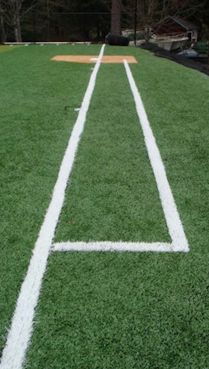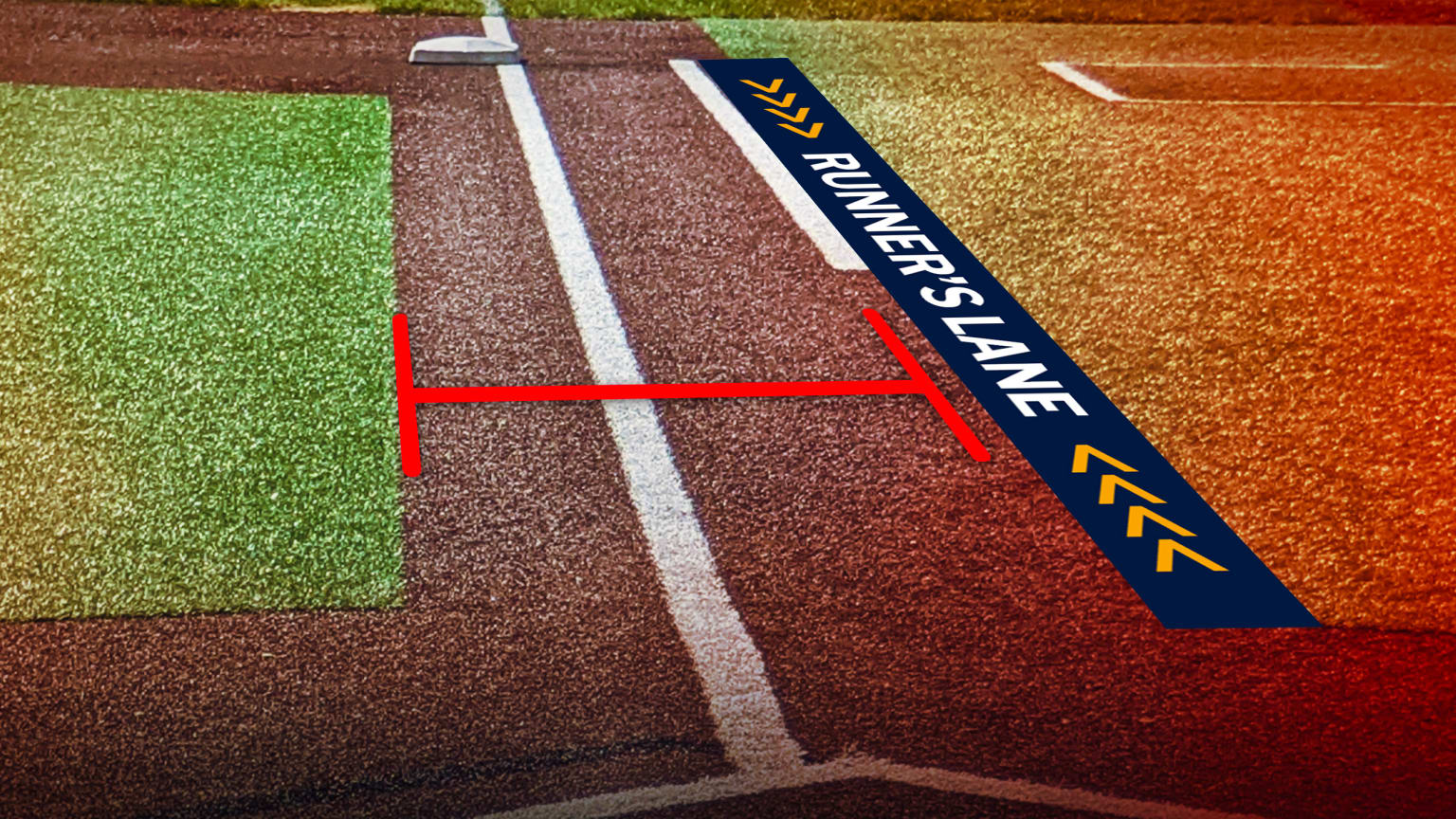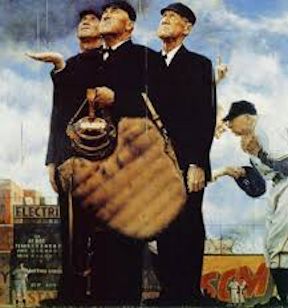 Base Path & Running Lane
Base Path & Running Lane
The first and most important thing to know about the base path is that there is no such thing as a base path (none exists) until a play is made on a runner. The base path is established when a fielder with the ball attempts to tag a runner. Then, and only then, is there a base path. And the base path is a straight line from the runner's position to the base to which he is advancing or retreating.
We're going to talk about that, as well as other important points pertaining to the base path and the running lane:
What is a base path?
The base path is defined in Rule 5.09(b)(1):
"A runner's base path is established when the tag attempt occurs and is a straight line from the runner to the base he is attempting to reach safely."
The wording is important. The base path is established (created) "when the tag attempt occurs." in other words, until there is a tag attempt, there is no base path. And then this: The base runner is out if "running more than three feet away from the baseline to avoid being tagged." At the moment the base path is established (when the tag is attempted), the runner cannot veer more than three feet to the left or right of the base path for the purpose of avoiding a tag.
It's important that a base path only exists when a fielder is attempting to make a tag. At all other times there is no base path (no such thing) and in fact the runner is free (at his peril) to run pretty much anywhere he wishes. There are limits to this (see Rule 5.09(b)(10) regarding "making a travesty of the game"); however, the central point remains: the base runner creates his own base path.
Here's where it gets tricky
It gets tricky in a pickle. When a runner is caught between bases and fielders have the runner in a pickle (a rundown), each time the fielders exchange the ball and the runner reverses direction, the runner has created a new base path . Each time you have this reversal you have a new base path because you have a new fielder attempting to make a tag (and therefore a new "straight line to the base"), and so you have to adjust your view of the base path accordingly. (On a side note, obstruction also comes into play in this scenario.)
So you have to be mindful that, during a pickle, the base path is going to migrate every time there's a throw. Depending on how long the pickle goes on, the base path can migrate quite a bit. When this happens, you invariably get some fan in the stands shouting at you "He's out of the base path!" But you and I know these fans don't know what they're talking about.
What about when the runner actually does run outside the base path to avoid a tag?
Rule 5.09(b)(1) allows a runner up to three feet either way off his base path to avoid a tag. More than that and the runner is out. Of course, you'll never see an umpire with a tape measure, so eyeballing that three-foot allowance takes experience and judgment. One helpful guidelines is noticing whether the fielder attempting to tag the runner, upon making a step and a reach, was able to tag the runner who is trying to pass him.
Abandoning the base path
Well, then, answer me this: If a runner creates his own base path, and if there's no such thing as a base path until a fielder attempts to tag a runner in the base path that he, the runner, has created, then how can a runner possibly abandon what doesn't even exist?
Well, the simple answer is because Rule 5.09(b)(2) says so. In truth, though, it's not really the base path the runner is abandoning (despite the wording in the rule), but rather the effort to continue advancing.
Rule 5.09(b)(2), along with 5.09(b)(2) Comment, tell us that if a runner leaves the base path and in doing so he "obviously" abandons any effort to reach the next base, then you call him out "if the umpire judges the act of the runner to be considered abandoning his efforts to run the bases." The ball remains live, however.
You don't see this very often. The most common scenario is when a base runner mistakenly believes he's been put out and heads for the dugout. There is no set guidance on how far the runner must go before he's technically abandoned the bases; the rule book says that he "progresses a reasonable distance still indicating by his actions that he is out." More often what you see is the runner's teammates screaming at him to get back to the base, or the defense noticing his blunder and putting a tag on. Then it's a matter of who wins the race back to the bag.
One final point. Jaksa/Roder extend their discussion of abandonment by introducing a new concept: "desertion" (Thirteenth edition, p. 48-49). The distinction recognizes that a base runner cannot (technically) be called out for abandonment before he reaches first base. So in cases where the runner can legally advance to first (e.g., on third strike not caught), but fails to, or hesitates overlong, then he is out for "desertion."
Another scenario is when a batter-runner is awarded first base on a walk, but because he is going to be replaced by a pinch runner, rather than advance to first base he goes directly to the dugout (and the pinch runner goes to first). Again, the batter-runner is out for desertion. That said, you might go 30 years without seeing that scenario.
What about the running lane?
There is a three-foot-wide running lane (54 to 60 inches wide in OBR starting in 2024) the last half (the last 45 feet) between home plate and first base. If you run outside this running lane while a play is being made from the vicinity of home plate (on a bunt, for example), you can be called out for interference. I said you "can" be called out for interference if running outside the lane. But not necessarily. I'll explain.

Existing running lane extending from the first base line to chalk line in foul territory.

New OBR running lane extending from grass line to chalk line in foul territory.
Our rules reference is 5.09(a)(11), which reads in part:
In running the last half of the distance from home base to first base, while the ball is being fielded to first base, he runs outside (to the right of) the three-foot line, or inside (to the left of) the foul line (the grass line in OBR since 2024), and in the umpire's judgment in so doing interferes with the fielder taking the throw at first base .....
When we said that you're not necessarily out for interference when running outside the running lane, we're calling attention to a few wrinkles in the rule. Here are the important points to remember when judging interference on 5.09(a)(11):
- First, let's define the running lane: A three-foot-wide lane (OBR changed this to the wider 54" to 60" running lane in 2024) occupying the last half of the distance to first base. The lines marking the running lane are part of the running lane. That's important.
- When is a runner out of the running lane? The batter-runner is out of the running lane when, during the last half of the distance to first base, one of the runner's feet (or both, for that matter) is entirely outside the running lane at the time that the interference potentially (but again, not necessarily) occurs.
- A throw must be made. If the catcher, for example, comes up with a bunted ball and sets up to throw to first, but then stops and doesn't throw because the runner (in his view) is in the way, you cannot have interference. The fielder must make an attempt to throw to first.
- The throw must be a catchable throw. Using the same example, if the catcher comes up with a bunted ball and then throws wild to first base because (in his view) the runner was in the way, you cannot have interference. The throw must be one that the first baseman has a reasonable chance (with ordinary effort) to catch.
- Note carefully the language of the rule: "… interferes with the fielder taking the throw at first base." So umpire judgment rests on what's happening with the fielder at first base, not the fielder who is making the throw. This is a critical point and is often misunderstood. Points #3 and #4 rest on this point: That if there is interference, the interference is on the fielder receiving the ball at first base, not on the fielder throwing the ball from the vicinity of home plate. You will sometimes get managers arguing running lane interference mistakenly arguing that the fielder who threw the ball was upset by the runner's position outside the running lane. He's entirely mistaken with that line of argument.
- There are two exceptions. There are two exceptions (wrinkles, really) in Rule 5.09(a)(11). First, the runner is permitted to leave the running lane to avoid a fielder attempting to field a batted ball. We know this already from what we've learned thus far about interference – that the fielder has the right of way in fielding a batted ball. Second, noticing that first base itself (the bag) is outside the running lane, the runner is permitted by rule to step out of the running lane for the purpose of touching first base. (This second exception no longer applies where the new OBR 54 to 60 inch wide running lane rule is in effect.)
So all of this rather begs the question: when do you have interference on a running lane violation? Well, the most common scenario is when you have the runner outside the running lane and the fielder's throw to first base is on line, but the throw hits the runner in the back (or head) causing the ball to drop uncaught. This is not the only scenario, of course, but it's probably the most common one. Kill the ball, call the batter-runner out for interference, and return other runners (if any) to their time-of-pitch base.
Rules Variation: High school (NFHS) rules differ on this point. See NHFS rule 8-4-1g. While OBR requires that the throw from the vicinity of home plate be "catchable" in order to have interference, NFHS rules don't make this distinction. Any throw to first base from the vicinity of home plate to retire a runner who is outside the running lane creates legitimate grounds for judging running lane interference.

